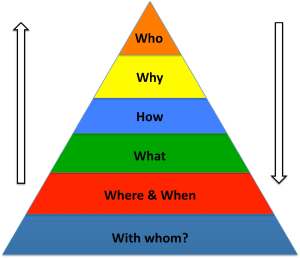
Sachertorte by Christian Stangier CC BY-NC 2.0
This week UWE put on a two-day intensive course for researchers on the topic of communication. The intention behind this was to go beyond a regular ‘presentation skills’ course, more to have a nose under the bonnet of communication to examine the fundamental principles that could be used to craft a range of effective messages suited to the purpose at hand. Researchers find it challenging to find ways of engaging others in the research they do for fear of losing its academic rigour.
I brought in Piero Vitelli from Island 41 to shape the course into something of real substance that would be of value to the participants. Piero used the analogy of the course being a bit like Sachertorte, an incredibly rich and calorie packed chocolate cake to describe the deliberate attempt to put a lot of content into the two days.
Speaking of packing content or data into a short space of time, here’s a clip that should demonstrate that it doesn’t matter how complicated your data is, it is important to make it accessible.
Over the two days we set out to try and understand the secret behind impactful, engaging communication of research.
The following notes summarising the course are reproduced here with permission from Piero.
The basic model of communication we put forward was as follows:
More often than not, when we set about preparing a piece of communication we pay too little attention to the upper half of the pyramid, we focus on the content; the “what” of our communication.
We spent a lot of time looking at the “why” of our communication or in other words, what is behind our motivation to tell others about our research, what are our values, what do we stand for. I’ve written about this sort of thing before, it comes down to asking yourself “why”. This then informs “how” we might go about delivering the content.
Much of the rest of the course was about looking at the techniques and/or qualities of effective communication– getting into the mechanics of it all.
The other major talking point of the course was around the issue of confidence. Everyone talks about the need to feel more confident when giving presentations and most people assume that others have more confidence than they. It’s a weird thing but a presenter’s job is not to feel comfortable but to give every fibre of their being to the audience, to forget how uncomfortable it feels.
Only others can give confidence because it is, after all, about being “with trust” (latin:- Con fidere), so literally only others can have trust in you. You can see this demonstrated in this clip featuring Paul Simon playing a concert in Toronto when he invites a fan on stage (named Rayna) to play the song she requested (“Duncan”) because it was the one she learned to play guitar on… watch how Paul Simon has trust in her and provides the encouragement.
How ‘confidence’ really works?
Some last thoughts, I really enjoyed the stories, the metaphors and the analogies used by various folks throughout the two days. I was amazed by the risks that the participants took in trying things out to explain, illuminate, highlight or inspire about research to bring things to life. Here’s one picture that springs to mind: what you see (the number 6, the maths symbol sigma or the number 9) all depends on your perspective…
Further resources
The following publication is actually a piece of research about the art of presentations among public interest professionals. It is equally as relevant to academia and has some of the best advice contained within around “chunking”, taking audiences on a journey from A->B, considerations about the use of visual aids etc. And it’s free.
Why Bad Presentations Happen to Good Causes (free download)
A blog site about all things presentation related. It’s a must read…
Image Attribution
Sachertorte by _chris_st available from Flickr at http://flic.kr/p/by8tRy under a creative commons 2.0 licence. Full details http://creativecommons.org/licenses/by-nc/2.0/






